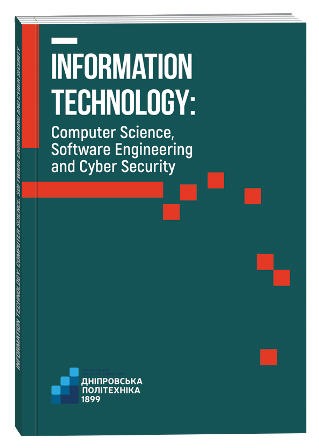МЕТОДИ ПРЕДСТАВЛЕННЯ 3D-ОБ’ЄКТІВ ДЛЯ НАВЧАННЯ ГЕНЕРАТИВНИХ НЕЙРОННИХ МЕРЕЖ
DOI:
https://doi.org/10.32782/IT/2024-1-8Ключові слова:
тривимірні об’єкти, моделі DCGAN, генеративної моделі нейронної мережі, генеративні змагальні мережі, варіаційні автокодувальники.Анотація
У роботі були розглянуті різні методи генерування тривимірних об’єктів за допомогою нейронних мережі. Було виокремлено ряд ключових елементи методологій такого типу синтезу нової інформації, на основі чого була запропонований новий спосіб представлення тривимірних об’єктів для його застосування в навчанні типових генеративних моделей нейронних мереж. Метою роботи є розробка такого методу представлення тривимірних об’єктів, який задовольняв би критерію високої щільності корисної для генеративної моделі інформації. Мінімізація надлишковості генерованої інформації разом з мінімізацією втрат, пов’язаних з процесом переходу з тривимірного способу представлення об’єкта в двовимірний (з яким існуючі генеративні моделі здатні впоратись доволі якісно), є ключовими аспектами запропонованого методу представлення. Методологія вирішення поставленої задачі полягає в побудові математичної моделі нового типу представлення тривимірних об’єктів; розробці програмного алгоритму, який реалізує математичну модель; та тестуванні цього представлення на базі типової генеративної моделі нейронної мережі. Наукова новизна полягає в тому, що вперше був запропонований такий тип представлення тривимірного об’єкта, який можливо використовувати для навчання типових генеративних моделей. Висновки. Запропонований метод представлення тривимірного об’єкта показав свою життєздатність навіть в контексті навчання маленької типової генеративної моделі DCGAN. Також були визначені перспективи подальших досліджень запропонованого методу для навчання інших типових генеративних моделей, адже цей метод може бути досить легко адаптований до представлень вхідних та вихідних даних великого спектру архітектур нейронних мереж.
Посилання
Ian, J. Goodfellow, Jean Pouget-Abadie, Mehdi Mirza, Bing Xu, David Warde-Farley, Sherjil Ozair, Aaron Courville, Yoshua Bengio. Generative Adversarial Nets. Archive of scientific articles arXiv, 9 p. arXiv: 2014. 1406.2661.
Description of the working principle of the VAE model. Medium WebSite. URL: https://towardsdatascience.com/understanding-variational -autoencoders-vaes-f70510919f73.
A general description of the existing methods of presenting three-dimensional models. Carlow Institute of Technology website, Ireland. URL: https://glasnost.itcarlow.ie/~powerk/GeneralGraphicsNotes /meshes/polygon_meshes.html.
Description of the most popular file formats for 3D objects. SelfCAD project site. URL: https://www.selfcad.com/blog/8-best-common-3d-file-formats.
Official documentation for Universal Scene Description. URL: https://openusd.org/release/index.html.
Jiajun, Wu, Chengkai, Zhang, Tianfan, Xue, William, T. Freeman, Joshua B. Tenenbaum. Learning a Probabilistic Latent Space of Object Shapes via 3D Generative-Adversarial Modeling. Archive of scientific articles arXiv, 2017. 11 p. arXiv: 1610.07584.
Charlie, Nash. The shape variational autoencoder: A deep generative model of part-segmented 3D objects. Charlie Nash, C. K. I. Williams. – GitHub website of article author Charlie Nash, 2017. 11 p. URL: http://charlienash.github.io /assets/docs /sgp2017.pdf.
AtlasNet: A Papier-Mache Approach to Learning 3D Surface Generation. Thibault Groueix, Matthew Fisher, Vladimir G. Kim, Bryan C. Russell, Mathieu Aubry. – Archive of scientific articles arXiv, 2018. – 16 p. arXiv: 1802.05384.
Matheus Gadelha. Multiresolution Tree Networks for 3D Point Cloud Processing. / Matheus Gadelha, Rui Wang, Subhransu Maji. – Archive of scientific articles arXiv, 2018. – 17 p. arXiv: 1807.03520.
PointFlow: 3D Point Cloud Generation with Continuous Normalizing Flows. Guandao Yang, Xun Huang, Zekun Hao, Ming-Yu Liu, Serge Belongie, Bharath Hariharan. – Archive of scientific articles arXiv, 2019. – 15 p. arXiv: 1906.12320.
Learning Representations and Generative Models for 3D Point Clouds. Panos Achlioptas, Olga Diamanti, Ioannis Mitliagkas, Leonidas Guibas. – Archive of scientific articles arXiv, 2018. – 18 p. arXiv: 1707.02392.
PolyGen: An Autoregressive Generative Model of 3D Meshes. Charlie Nash, Yaroslav Ganin, S. M. Ali Eslami, Peter W. Battaglia. – Archive of scientific articles arXiv, 2020. – 16 p. arXiv: 2002.10880.
Occupancy Networks: Learning 3D Reconstruction in Function Space. Lars Mescheder, Michael Oechsle, Michael Niemeyer, Sebastian Nowozin, Andreas Geiger. – Archive of scientific articles arXiv, 2019. – 11 p. arXiv: 1812.03828.
Comparison of different configurations of the GAN model based on the AWS cloud computing service. Information Technology: Computer Science, Software Engineering and Cyber Security. B. Moroz., L. Kabak, K. Rodna, E. Ruksov, 2, 2022. p. 61–78. https://doi.org/10.32782/IT/2022-2-7.







